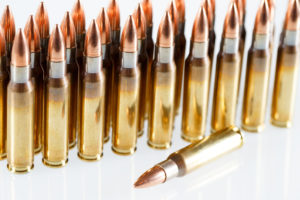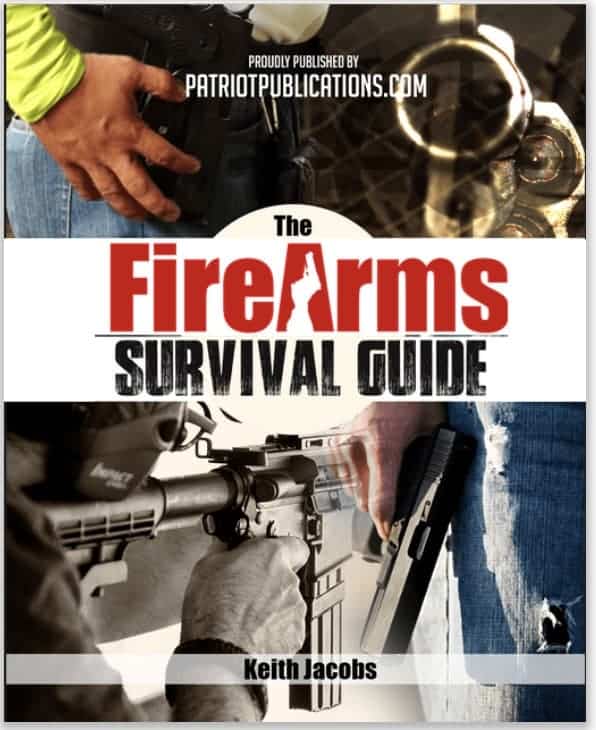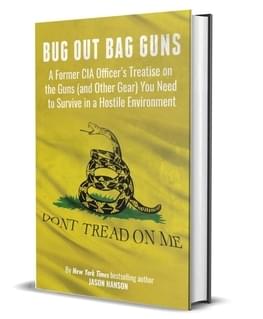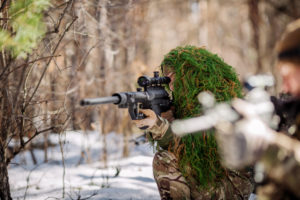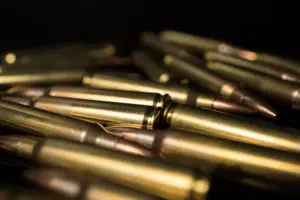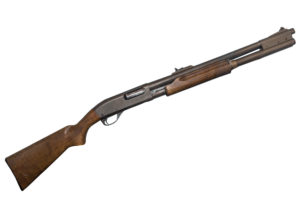Our “9mm vs. 45” Survival debate was a popular one, so we’re going to take it one step further and go to the ultimate U.S. Military
Before we get started, if you want to design a BOB with the proper guns, and gear, check out this guide from our team member and former-CIA officer:
SKIP AHEAD
The .308 Winchester
The .308 Winchester was brought out as a sporting cartridge in 1952, and was made by
.308 Pros:
1. Inherently a brilliantly accurate cartridge, even out to 1,000 yards
2. Very versatile, with a wide range of bullet weights an profiles to accomplish everything from varmint hunting to big game hunting to sniping.
3. Heavier bullets retain velocity and energy better at longer ranges, especially with modern VLD (Very Low Drag) projectiles. Reach out and touch someone with NO problems.
4. Larger diameter bullet (.308”) coupled with heavier weight means more surface area for knock-down power, and deeper penetration in targets.
5. Still a standard U.S. Military caliber, with ammunition relatively easy to come by in bulk.
6. The .308 is a reloader’s dream, being very accommodating of a wide range of projectiles and powders, with usually excellent accuracy.
.308 Cons:
1. .308-chambered rifles are larger and heavier than their equivalent .223 brethren.
2. Magazines for .308 battle rifles are generally harder to come by.
3. Magazines are generally only 20-round capacity at their largest, and even at 20 rounds, are much heavier loaded than even a loaded 30-round AR-15 magazine.
4. Personal magazine and round loadout generally is lower, due to added bulk and weight of .308 cartridge.
5. The larger bulk of the .308 cartridge means it is more expensive to buy and takes up more storage space on the ammo rack.
6. .308 sporting rifles are very easily obtained, but .308 battle rifles (M14/SOCOM, HK 91, FN FAL/CETME, etc.) are more difficult to find and expensive to buy than their .223 brethren.
The .223 Remington
The .223 was developed more or less concurrently with the M16 rifle in 1963, as an offshoot of the .222/.222 Remington Magnum line of
The U.S. military wanted a caliber that would have a higher round loadout and high lethality, with reduced recoil and higher rate of fire. Analysts showed that the standard infantryman could carry roughly twice the amount of ammunition per man versus the 7.62×51/M14 package, and therefore would theoretically bring more firepower with a faster-handling rifle.
This was also thought to hold true when compared to the NVA’s AK-47/7.62x39mm combination. After some teething issues, the M16 and its new cartridge ended up proving to be a useful package, and it has proven itself well enough to still be the standard U.S. infantryman’s rifle to this day, 52 years later.
The caliber has become very popular in the civilian market, with varmint and small game hunters taking a liking to its low recoil and blast, flat trajectory and speedy lightweight bullet, and readily available surplus brass supply for reloading. Preppers, survivalists, police forces, and the everyday gun enthusiast have flocked en masse to the AR-15, the civilian version of the military M16, for the same reasons the military adopted the caliber.
.223 Pros
1. Very good to excellent accuracy, as well as low recoil and low report.
2. Excellent performance on small game, varmints, and even animals up to the size of a deer with proper bullet selection and careful bullet placement.
3. Wide range of loadings available, from 36 grain varmint loads that fragment quickly in unwanted critters, to 90 grain VLD bullets that retain flat trajectories at intermediate (out to 500 yards or so) ranges.
4. Sheer popularity of the AR-15 platform means that ammunition, magazines, spare parts, and upgrades will be easily obtainable for the foreseeable future. Vast numbers improve odds of pick-up or salvage guns for parts or use.
5. Light weight and small size of .223 cartridge means that more rounds can be carried in a given area or on a person than the .308, which is much heavier.
6. .223 ammuntion is of small size and takes up less storage space in bulk
7. .223 is reasonably lethal to 300 yards or so for the average shooter.
8. Light weight of rifles and low recoil means less training time to master, andeasier use in field
9. Can be converted to .22 Long Rifle in a pinch for training or small-game hunting
10. Easy to reload with good to very good accuracy resulting.
.223 Cons
1. Relatively low bullet mass and diameter (.224”) means less frontal area for knockdown power and less penetration, especially on hardened targets
2. Bullets theoretically prone to “tumbling” (spinning end over end), which may be a good or bad thing depending on terminal ballistic viewpoint. “Tumbling” bullets theoretically do more terminal damage, but penetrate much less farther.
3. Lower energy and lower penetration of lighter bullets means that the cartridge is out of big-game hunting territory.
4. Even with heavier, longer bullets, the .223 loses its velocity much more quickly than the .308, limiting its practical effectiveness to 500 yards with 69+ grain bullets, and probably 300-400 yards with 69 grain and lower bullets.
5. The lightweight bullet of the .223 is very susceptible to wind drift, even at short distances.
6. The .223 seems to be more bullet weight and rifling-twist sensitive than the .308, with the same bullet and load accuracy varying greatly even between 1:7 and 1:9 twist rifles.
308 vs 556 Caliber Comparison
To compare size differences between .308 and .223 rifles, let’s compare one excellent company’s lineup of equivalent rifles, one in .308
Also Read: SOCOM 16 Battle Rifle Review
.308 Win. SRC: (link to full specs here)
Overall Length: 38” with stock extended, 34.1875” with stock collapsed
Weight: 7.55 lbs. with empty 20-round magazine
Barrel length: 16.5”
MSRP: $1,413.00
.223 SRC: (link to full specs here)
Overall Length: 36.125” with stock extended, 32.375” stock collapsed
Weight: 6.3 lbs with empty 30-round magazine
Barrel length: 16”
MSRP: $1,040.00
Keep in mind that M14 based platforms, HK91s, and FN-FAL based platforms are all substantially heavier than their AR10 counterparts.
Individual Loadout Comparison (data from 7.62x51mm NATO Wikipedia)
RIFLE CALIBER WT. OF LOADED MAG 22lb. AMMO LOAD
M14 .308 Win 1 lb 7 oz. / 20 rounds 14 mags – 280 rounds
M16 .223 Rem 0 lb 10.5 oz / 20 rounds 33 mags – 660 rounds
Ballistics (standard US military loadings)
.223/5.56x45mm M855 – 62 grain Full Metal Jacket (FMJ), 20” barrel
- 3,025 feet per second (FPS) velocity at the muzzle
- 1,260 foot-pounds of energy (FPE) at the muzzle
.308/7.62x51mm M80 – 147 grain FMJ, 22” barrel
- 2750 feet per second (FPS) velocity at the muzzle
- 2462 foot-pounds of energy (FPE) at the muzzle
Cost Per Round as of 1/4/2015: (costs taken from Brownells.com)
- M80 7.62×51: 500 rounds for $345.00, $0.69/round
- M855 5.56×45: 600 rounds for $340.00, $0.57/round
Of course, prices vary based on quantity and manufacturer, these prices were taken as examples. You can check out the websites below for better pricing:
 |
|
Check Latest Pricing | |
 |
|
Check Latest Pricing |
Pick Your Poison (556 vs 308)
The Balloon goes up, you have to bug out the door. You have a .223 battle rifle and a 7.62 battle rifle, each with a full standard 22 lb. loadout. What do you grab (only one, please!) and what is your reasoning? Sound off in the comments below!


